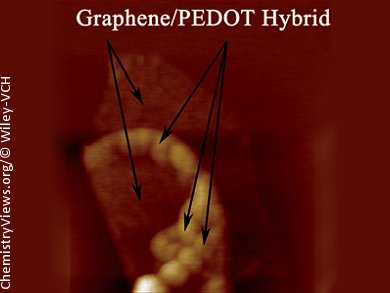Graphene, which consists of atom-thick sheets of carbon organized in a honeycomb structure, has unique electrical, optical, catalytic, and mechanical properties. It can be used in a large variety of applications such as for nanoelectronics, sensors, batteries, supercapacitors, and hydrogen storage. Versatile materials such as polymers, carbon nanomaterials, small organic molecules, metal nanoparticles, and the nanoparticles of metal compounds have been used for functionalization of graphene.
A conceptually new method to functionalize graphene has been reported by Jian-Rong Zhang, Jun-Jie Zhu, and co-workers, Nanjing University, China. The figure outlines their approach.

GO = Graphene oxide, G = Graphene, EDOT = 3,4-ethylenedioxythiophene, PEDOT = poly(3,4-ethylenedioxythiophene)
Atomic force microscopy, UV/Vis spectroscopy, X-ray photoelectron spectroscopy, and energy dispersive X-ray spectroscopy were used to characterize the materials of interest. Cyclic voltammetry and galvanostatic charge–discharge measurements were applied to determine the electrochemical performance of the graphene/PEDOT hybrid. The graphene/poly(3,4-ethylenedioxythiophene) (PEDOT) hybrid as the supercapacitor electrode materials afforded high specific capacitance and good cycling stability – 93 % retention after 10000 cycles at a high current density of 5 A g−1 – during the charge-discharge process. A maximum specific capacitance as high as 270 F g−1 at a current density of 1 A g−1 was achieved in 1 M H2SO4 electrolyte solution. The energy density of the hybrid could reach 34 W h kg−1 at a power density of 25 KW kg−1.
- Microwave-Assisted In Situ Synthesis of Graphene/PEDOT Hybrid and Its Application in Supercapacitors,
Dong Sun, Li Jin, Yun Chen, Jian-Rong Zhang, Jun-Jie Zhu,
ChemPlusChem 2013.
DOI: 10.1002/cplu.201200206




